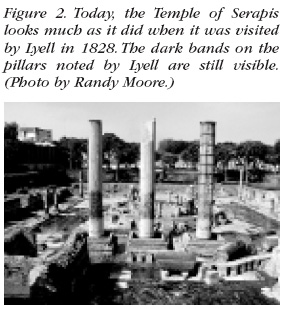The Serapeum is a structure better known to scientists as the Temple of Serapis, named for an Egyptian deity worshiped by Romans. It stands along the coast just north of Pozzuoli, Italy. Stone used by Romans to build the temple had originally formed as limestone sediment at the bottom of the sea, where it metamorphosed into marble, and millions of years later was raised as land. Approximately 2000 years ago, the marble was quarried, carved into pillars, and set into the temple, which originally was a marketplace and spa for wealthy Romans. Since that time, sea levels changed several times and in the process the temple was repeatedly submerged and exposed. The volcanic features around the Temple of Serapis helped inspire Virgil's account of the entry into the underworld in the Aeneid.

For most geologists,the Temple of Serapis is more than a monument of ancient art. For example, John Playfair — in a chapter titled "Changes in the Apparent Level of the Sea" — discussed the temple in his Illustrations of the Huttonian Theory of Earth (1802). The temple was also visited by Charles Babbage, Emma Darwin, and several other people associated with the creationism/ evolution controversy. However, the scientist most closely associated with the temple is geologist Charles Lyell, who made it an icon of uniformitarianism when he used a drawing of the temple's columns as the frontispiece of his monumental Principles of Geology: Being an Attempt to Explain the Former Changes of the Earth's Surface by Reference to Causes now in Operation (Figure 1),a book that the late Stephen Jay Gould described as "the most famous geological book ever written." Lyell, who wanted to "free the science [of geology] from Moses,"emphasized that the geological changes that have been shaping earth for millennia are observable today. Lyell's ideas about the Temple of Serapis prompted Richard Fortney (author of Earth: An Intimate History) to describe the ruins as a "holy place for rationalists." What makes the temple such an important place for geologists?
When Lyell visited the temple's ruins in 1828, its three remaining marble pillars — each some 40-feet high — were still standing (the fourth column lies in pieces on the temple's floor). In Principles of Geology, after describing the columns as "smooth and uninjured to the height of about twelve feet above their pedestals," Lyell made his most important point: "Above this is a zone, about nine feet in height, where the marble has been pierced by a species of marine perforating bivalve, Lithodomus." (Lithodomus is a genus of clams that burrow into piers and boatmoorings.) Since these clams cannot live above the low-tide line,Lyell concluded that the columns had at one time been underwater (many of the columns' holes still have shells of Lithodomus in them). The original temple had been built above sea level, but the presence of the mollusks on the columns meant that the columns had been partially submerged and were standing upright in the ocean. The columns had then been raised to their present level by the volcanic eruption that produced Monte Nuovo just northwest of Pozzuoli.
Because the lowest parts of the Temple's columns were not bored by bivalves, Lyell suspected that these parts of the columns had been buried in volcanic sediments. He was right; these sediments had been excavated in 1749 — almost 80 years before his visit. While at Pozzuoli, Lyell also noted that two other temples were submerged just offshore northwest of the Temple of Serapis. Since these changes had occurred during recorded history, Lyell concluded that the same geological processes — over the expanse of geological history — could build mountains, valleys, and all the other geological features we see today.

Lyell had a dramatic and immediate impact on Charles Darwin; as Darwin noted,"I never forgot that almost everything which I have done in science I owe to the study of [Lyell's] great works." However, Lyell was reluctant to accept Darwin's ideas about evolution, especially as they related to humans. Darwin's On the Origin of Species, which to many was an inevitable sequel to Lyell's advocacy of uniformitarianism, troubled Lyell, who did not initially accept the same degree of continuity of life as he claimed for the physical features of the earth's surface. However, Lyell finally admitted that Darwin's On the Origin of Species was "a splendid case of close reasoning" and that "I have been looking down the wrong road."
Today, the Temple's pillars — which remain standing (Figure 2) — are pictured on the reverse of the prestigious Lyell Medal, which is awarded by the Geological Society of London.
